| Published in the April 2001 Issue of Anvil
Magazine
Note: Photos with captions appear at the endo fo this article What causes laminitis, and how can it be prevented? What are the latest breakthroughs in protocol treating this debilitating, life-threatening disease? (See the following article: A Case Study in Laminitis.) Dr. Ric Redden assembled a team of ten speakers at his 14th annual Bluegrass Laminitis Symposium in Louisville, Kentucky, January 25-27, 2001 to address these and other related issues. Drawing a crowd of around 450 farriers and veterinarians in a massive chandelier-studded hall nearly the size of a football field, I found myself one of the privileged farriers attending the event. Presenting the latest research on laminitis and a smattering of related topics ranging from treating navicular disease to how to tune up and maintain your radiographic (x-ray) equipment, the Symposium was fast paced, detailed and in depth. The Symposium consisted of an abundance of raw material presented in a full 18 hours of lectures, complete with slide presentations on two huge silver screens at the front of the auditorium. Live horse demonstrations given on the last day were videotaped on the spot in a makeshift equine surgery room across from the main hall and projected onto the large screens for all to see. In addition to shoeing demonstrations, Dr. Redden brought in an amputee mare with a hind limb prosthetic, and he even performed surgery to cut the superficial flexor tendon on a chronic laminitic horse. He fitted it with a handmade, glue- on, clipped aluminum plate shoe with an extended toe and high, curled heels to add the support required after the surgery. The symposium is international in nature, with representatives from 16 countries represented at this year's event. Cultural differences in presentation style set the mood: the Europeans presented data in the more fact-filled, fast-moving style of their British veterinary peers, presenting facts on stress and load tests with reams of raw data. I am told that the veterinary curriculum in England is three years compared to our four, and the material presented there is fast and furious. The American speakers addressed the symposium in a somewhat more casual manner-yet, as most of us attendees were farriers, our brains were pressed to absorb the many complex veterinary terms and descriptions. We've all heard of a rockered toe, but the latest breakthrough in shoeing concepts may contain a rockered heel, as well. Dr. Ric Redden introduced his latest concept in correctional shoeing at the Symposium: the `banana' shoe, or `magic pivot'-a fully rockered shoe (like the bottom of Grandma's rocking chair) that allows the lame horse to find his most comfortable load stance, effectively bringing the breakover point back to well behind the coronary band. "This aggressive breakover technique has offered my patients a quicker turnaround and put them back into training much quicker than with my previous point of breakover," Dr. Redden explained. Based on his extensive study of over 1800 wild horses, Dr. Redden observed a smooth, burnished heel `landing zone' on the feral horse hooves, giving it an almost rockered heel. He uses a special jig set on the anvil to achieve the fully rockered effect, and demonstrated the shoe on both a club-footed foal (which he said should correct itself with use of the shoe) and a chronic laminitic horse. Dr. Redden says traditional horseshoeing has its place as long as it is working for the horse. He recommends his banana shoe for compromised (laminitic, club footed, or navicular) horses, because once the horse has developed certain pathologies, he says: "You cannot correct the problems caused by traditional shoeing with traditional shoeing." Dr. Redden hypothesizes that the four- point trim enhances the `pump' of the foot, not by the frog but by the action of the deep flexor tendon. This has the effect of squeezing blood out of laminae when the foot is loaded and allowing the foot to refill rapidly when unloaded, thus moving large volumes of blood throughout the laminae with each footstep. This provides the cooling system for the foot at speed. In order for us to better grasp his concepts, Dr. Redden placed gray plaster models of actual hooves dressed with four-point trims in front of us on the seemingly endless rows of tables. I found the presentation by Bernard Duvernay, humanitarian and Consulting Farrier from Switzerland, to be a most moving lecture. Documenting his travels to third- world countries in his effort to upgrade working farrier skills throughout the globe, his exotic slide presentation had both heart and brawn. Nicknamed by friends `the flying anvil,' Bernard presented vivid images of women in India wearing bright sari dresses contrasted with street scenes of countless ponies and horses hitched to large-wheeled carts and burdened with awkward loads. Horses are still the main form of transportation in India today and the streets are filled with them, as well as camels, oxen, donkeys and even working elephants. There are still 100 million working equines (including donkeys) in the world today-and there are 15 million working bullocks (oxen) in India alone. Did you know that the farriers in India make their own horseshoes out of rebar? And an entirely different team of workers makes the shoes than the ones who apply them to the horse. Many farriers in India are aided in their heavy work by the help of their wives. The finest craftsmen are the oxen farriers, due to the fine white line of the oxen cloven feet which require more precision than work on horses. In order to obtain the greatest skill level and result, Bernard often recruits oxen farriers and trains them to work on the horses at the Thoroughbred farms where he consults. And the most amazing fact to me is that many of the farriers in India work in their bare feet, as most are too poor to own shoes. I shall never forget the parting shot of Bernard's moving slide presentation of a bare human footprint with the outline of all the toes, surrounded by hoof shavings like so much coconut. The next time I complain of sore hands or feet or muscles, I shall try to think of those people, working with no shoes or aprons, in monsoon rains and tropical heat, enduring the grueling job of horseshoeing with only the crudest of tools. We here in America, and in the other developed countries, have so much to be grateful for. The latest treatment for navicular syndrome was presented by Dr. F. Desbrosse, veterinarian from France, classifying the crippling disease into six specific forms with protocols to address each type. He demonstrated a simple and effective test for severity of navicular syndrome using a long board on the ground as a lever, placing the horse's front feet, one at a time, at the end of the board, with the other end extending forward from the horse. He then manually raised the board and checked for pain in this `reverse flexion' (toe up) position. He also pointed out that the discomfort of the disease causes secondary pathologies in the tendons, ligaments, and the horse's back itself, which must be taken into account and treated. In fact, if the back pain clears up without recurring after overall treatment, it indicates the success of the treatment. Also on navicular syndrome, gait analysis data presented by Dr. Alan Wilson of the Royal Veterinary College, London, England, concluded that: "Horses with navicular syndrome attempt to unload their heels by the contraction of the deep digital flexor muscle. This results in a higher compressive force being exerted on the navicular bone throughout the stance. This may account for the intractable and progressive nature of navicular syndrome." It was also noted that a heel wedge delays breakover, causing one to think about how raising the heels affects the way the rest of the foot needs to be prepared and shod. On that note, the Natural Balance Shoe (NBS) received rave reviews in several of the talks given at the Symposium, due to its ability to reduce tension on the deep digital flexor tendon (DDFT) at the time of breakover. Dr. Alan Wilson of the Royal Veterinary College presented a load test on how the Natural Balance Shoe (set to breakover in the prescribed position relative to PIII) affected footfall. Although the test showed there was no real difference medially/laterally between it and the other shoes tested (a toe clip shoe and a side clip shoe set to breakover just inside the hoof wall) and no real change in moment, both the stance time and the breakover time was shortest with the NBS. Peak moment and peak force was smaller with the NBS shoe, indicating that it is a good choice for navicular syndrome, as well as the overall prevention of lameness. The marketplace at the Symposium was professional and well presented with over 50 neatly curtained booths. Bustling with people searching for free rasps, shirts and tape measures-in addition to the best available good, old-fashioned farrier supplies-were the latest in computer programs and technology, magazines, books, artwork, feed supplements, salves, lotions, and even radiographic machines. Horse art is big business in Louisville, where, after landing at the airport, I was greeted by a large, winged Pegasus hung above the escalator and several other `horsy' logos, reminding me that Kentucky is the heartland of America's Thoroughbred industry. At the marketplace, blacksmith Kevin Fahey of Mocksville, North Carolina, offered his beautiful miniature custom hand-forged stainless jewelry and belt buckles. Kevin says he's getting too old to keep making these items and many people bought them up for their beauty and superb craftsmanship, as well as to have souvenirs of Kevin's work. (I have a pair of his tiny silver horseshoe earrings, and they are my treasure.) Also available for sale was a huge life-sized horse made of 400 used horseshoes by Georgian farrier Gerald Douberly. In addition, there was a separate art gallery with special custom artwork, including beautifully forged and polished display pieces of flowing-maned horses. There was also a blacksmithing demonstration featuring Belgian blacksmith Roger Bockstaele who, aided by a translator, demonstrated his intricate forging skills, hammering out a delicate bird from a photograph. Among the new products presented at the marketplace, OSHA products of Bellevue, Washington, displayed their exciting new `SanSock' soaking boot/bucket and the OSHA Load Sharing (foam hoof support) System. If you've ever had to soak a horse's hoof for an extended period of time, you'll appreciate the SanSock boot, available in three sizes (pony, light horse and draft). The bucket at the end of the boot is made of dense foam covered in a sturdy, waterproof ballistics cloth (the same material bulletproof vests are made from) to hold the liquid soaking solution. A large nylon sleeve with Velcro fasteners extends from the bucket and wraps up the horse's leg to hold the whole thing in place, turning the entire bucket into a boot. The OSHA Load Sharing System is designed to be used like Styrofoam blocks for a laminitic or sore horse. It has a variety of high- density, hoof-shaped foam pads which compress at different rates and depths, allowing you to devise a custom package to accommodate a sore-footed horse. The neatest part is the wrap-up outer cover-the Hoof Hugger-a star-shaped fastener with Velcro strips. Tough enough to last, the Hoof Hugger wraps up around the hoof, holding the entire package in place and allowing horse owner or farrier to easily access the hoof in order to soak the foot or change the pads. (See Web site: www.oshaproducts.com) Another marketplace feature was the Metron computer technology from EponaTech. Stanford PhD. John Craig and his wife Monique, an engineer, have developed software which helps document and analyze photographs and radiographs of the equine hoof and lower leg. A scoring system is used to compute and evaluate the quality of the equine foot. These measurements are valuable in preventive hoofcare programs, for example, in keeping track of any changes, or for comparing a specific horse to a database of other horses over time. An e-mail feature is available in the software which makes it easy to send and receive images and other data, thus facilitating interaction and communication between veterinarian and farrier. The exhibit attracted attention from veterinarians and farriers alike, and Bernard Duvernay showcased the program's use in his fine shoeing demonstration on a navicular horse on the last day of the Symposium. (www.eponatech.com.) For those interested in fine tuning their physical bodies, the heartiest among us- about a dozen driven souls-showed up for the early morning stretching sessions held daily from 6:00 am - 7:30 am. Kellie Carpenter, personal fitness trainer and wife of horseshoer Steve Carpenter, led the dedicated group through a challenging series of stretching exercises guaranteed to make you feel twice your age and weight. After all, our human bodies are the most complex tool in our toolbox! The highlights: ice is the best pain remedy and should always be in your rig-either in your lunch box, or carry a chemical ice pack from the pharmacy-just break the inner packet for instant cold. When you have sore muscles or injure yourself, pack it in ice. When you injure yourself, stop working! An excellent farrier in my part of the country ignored his back injury and kept working a few more weeks-until he couldn't get out of bed one day. Because he didn't take the time off to heal from his original injury, he destroyed his disks. Now, tragically, he is no longer able to shoe. We farriers are a tough breed, or we would never be able to do what we do in the first place. If you injure yourself, STOP. To continue working could be the end of your career. My favorite first aid remedies are two homeopatic ones: arnica montana and hypericum perf., which really help with pain, sore muscles and smashed fingers. You can get them at any health food store for under $6.00. They are little white sugar tablets that melt in your mouth, giving instant relief. Arnica is a remedy for shock and should be taken immediately with any injury; it also is specific for sore muscles. Hypericum is for nerve damage and nerve pain, like smashed fingers. They require no refrigeration, are in small bottles that you can keep in the glove box of your truck, and they really work- instantly. Aside from stretching both my mind and my body at the Bluegrass Laminitis Symposium, the social aspect of seeing friends and making new ones was a pleasure. Dinner at the revolving restaurant on the 25th floor of the Galt House overlooking the Ohio River was very memorable. It was especially enjoyable getting to know some of the farriers from other countries and finding out how they do things in their part of the world. |
|
| Neon racehorse logo at Louisville airport | 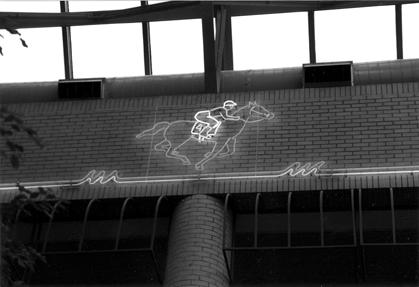 |
| Winged Pegasus greets travelers at Louisville airport | 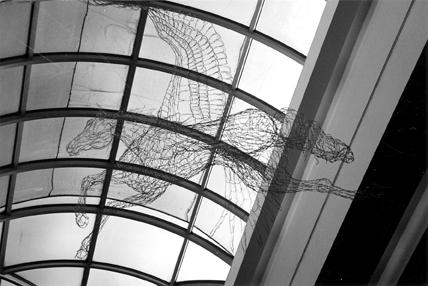 |
| Dr. Alan Wilson of the Royal Veterinary College, London, England, fields questions after his lecture on load analysis | 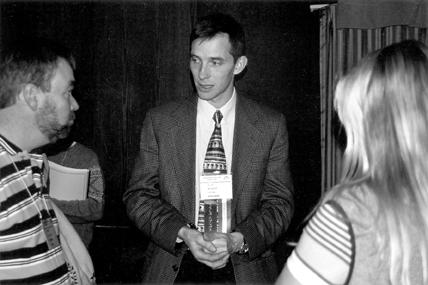 |
| Farrier Matthew Frederick and his wife Susan answer questions about their lecture regarding their theory on Cushing's-related laminitis | 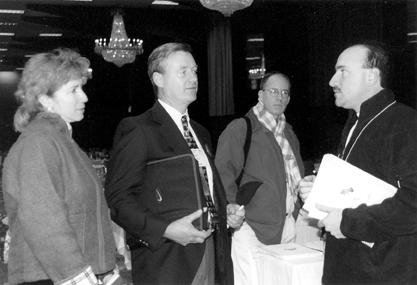 |
| Mark Plumlee with Author Dawn Jenkins at the Marketplace | 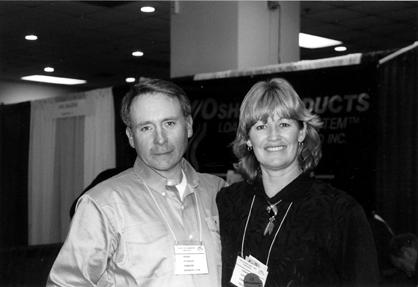 |
| OSHA products: Hoof Hugger prototype and Foam Load Sharing System | 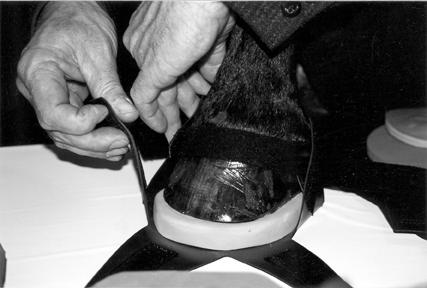 |
| Jan Crawford of Sympathetic Imaging Systems at the Marketplace shows their MEDITHERMr software | 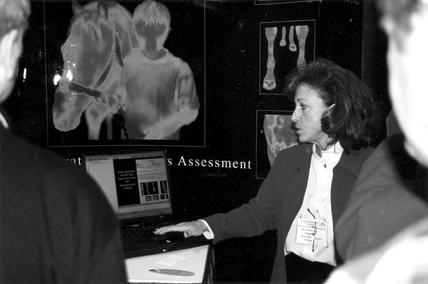 |
| Monique and John Craig of Epona Tech debut their unique Metron computer software system |  |
| Dr. Ric Redden and Canadian farrier, Bernard Pelletier, examine Redden's fully rockered `banana shoe' | 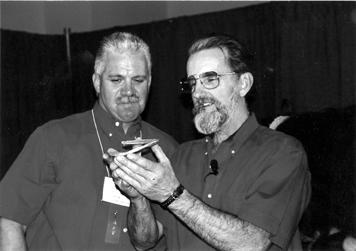 |
| Dr. Redden's rocker `banana shoe' on chronic laminitic horse |  |
| Roger Bockstaele hammers out intricate work on a bird in blacksmithing demonstration |  |
| Dr. Redden, Dr. Desbrosse of France, farrier Bernard Pelletier of Canada, and Bernard Duvernay of Switzerland examine radiographs of Redden's rocker `banana shoe' | 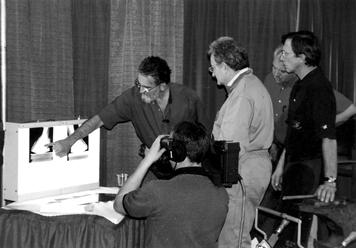 |
| Return to the April 2001 Table of
Contents
Return to the Farrier Articles Page
|
|